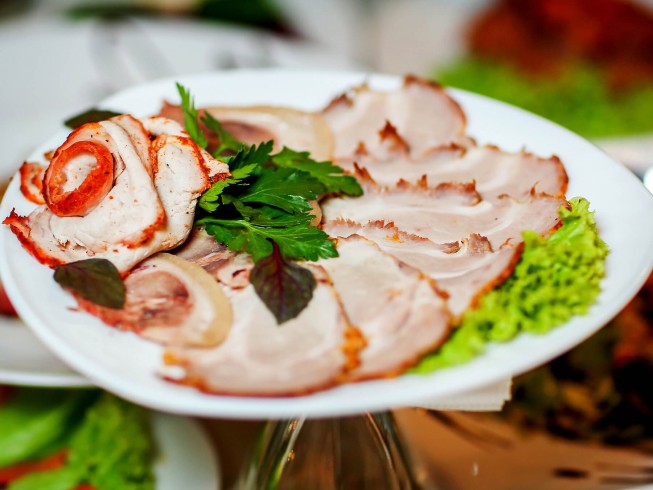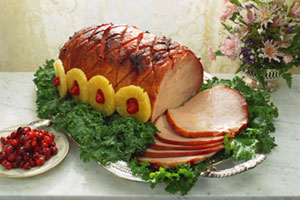Love the spinach dip at restaurants like TGIFriday's and the Olive Garden? Make it at home with these easy-to-follow copycat recipes.

Country ham is baked with an orange juice and brown sugar baste and served with a sweet and savory port-wine sauce.

14 pounds country ham
whole cloves
2 cups orange juice, divided
3/4 cup firmly packed brown sugar
1 jar (18 ounce size) apple jelly
1/2 cup port wine
1/4 teaspoon onion juice
1/2 teaspoon ground ginger
1 pinch black pepper
Place the ham in a large container and fill with enough cold water to cover it completely. Let the ham soak overnight.
Remove the ham from the water and drain. Scrub the rind of the ham and rinse well. Place the ham in a Dutch oven or other large pan and cover with water. Bring the water to a boil over high heat. Reduce the heat to a simmer and let cook, covered, for 1 hour.
Drain off the water. Replace the water and cover and simmer the ham for 4-5 more hours. Turn the ham occasionally during the cooking time. Remove the ham from the water and let cool completely.
Combine half of the orange juice with the brown sugar and mix well. Set aside.
Preheat the oven to 325 degrees F.
Remove the skin from the ham. Place the ham on a cutting board, fat side up. Score the fat in a diamond shape with a sharp knife. Press whole cloves into the cuts. Transfer the ham to a roasting pan. Brush the fat side of the ham with the orange juice and sugar mixture.
Place the ham in the oven and bake at 325 degree F for 30 minutes, basting frequently with the remaining orange juice.
Meanwhile, heat the apple jelly, port wine, onion juice, ginger, and black pepper in a saucepan.
Place the ham on a cutting board and slice as desired. Serve the sliced ham with the apple-wine sauce.
For the best results, choose a bone-in country ham, as it tends to be juicier and more flavorful.
Always use a meat thermometer to make sure the ham is cooked thoroughly without drying it out.
Try adding a pinch of orange zest to the apple jelly mixture for added flavor.
When scoring the fat, make shallow cuts to prevent cutting too deeply into the meat.
Let the ham sit on the cutting board for about 30 minutes before serving to help retain its juices.
Use the leftover bone to create a delicious stock or broth for soups.
For a more vibrant sauce, add diced apples or pears to the sauce mixture while simmering.
Baste the ham frequently for best flavor.
Try adding herbs like rosemary or thyme to the glaze for added flavor.
Country ham is a type of cured ham that is typically salted and often aged for several months or longer.
Soaking helps to remove excess salt from the curing process, which will help make the ham less salty and improve its overall flavor and texture.
While country ham is best for this recipe, you can substitute with a city ham or spiral-cut ham, keeping in mind that cooking times and flavors will vary.
Scoring helps the fat render during baking, allowing the flavors of the glaze to penetrate and boosting the overall taste and appearance.
You can skip the port wine. If needed, substitute with grape juice, additional apple juice, or broth, but it will alter the flavor of the sauce a bit.
Alternatives include peach jam, apricot preserves, or a homemade fruit glaze.
A ham is done when it reaches an internal temperature of 145 degrees F. It should also be tender and easy to slice.
To thicken the sauce, you can simmer it longer to reduce the liquid or add a cornstarch slurry (mix cornstarch with cold water) and stir it into the sauce until it thickens.
Leftover ham should be wrapped tightly in plastic wrap or aluminum foil and stored in the refrigerator for up to 5-7 days.
Yes, leftover ham can be frozen. Slice it first, then store it in airtight freezer bags or containers for up to 2-3 months.
For best results, wrap the ham in foil and reheat in the oven at 325 degrees or an air fryer. Foil helps keep the ham moist. You can also reheat slices of ham in a skillet on the stove. The microwave isn't recommended for reheating ham as the small fat pockets tend to "explode" in the microwave when heating.
You can soak and even bake the ham a day ahead; simply reheat gently before serving, allowing the flavors to meld.
If you don't have a Dutch oven, a large stockpot or a deep roasting pan covered tightly with aluminum foil can work as an alternative.
Dutch Oven or Large Pan: For simmering the ham in water. A Dutch oven is ideal due to its large size and ability to retain heat.
Large Container: For soaking the ham in cold water overnight. It should be large enough to make sure the ham is fully submerged.
Measuring Cups and Spoons: For measuring ingredients such as the orange juice, brown sugar, and ginger.
Sharp Knife: For scoring the fat of the ham in a diamond shape and for slicing the ham once it's cooked.
Roasting Pan: To hold the ham while it bakes in the oven. It should be large enough to accommodate the ham, with some space for basting it on all sides.
Basting Brush: For applying the orange juice and sugar mixture onto the ham during the baking process.
Saucepan: For heating the apple jelly, port wine, onion juice, ginger, and black pepper to create the sauce.
Cutting Board: Provides a surface for handling and slicing the ham safely.
Roasted Sweet Potatoes: The natural sweetness of roasted sweet potatoes will complement the rich, savory flavors of the ham and provide a nice contrast in texture.
Green Beans Almondine: The crispness of green beans paired with the nuttiness of almonds adds a refreshing and slightly earthy note that balances the sweetness of the ham.
Cranberry Sauce: A tangy cranberry sauce would provide a bright contrast to the rich flavors of the ham, adding a fresh dimension that cuts through the sweetness.
Honey-Glazed Carrots: Sweet, tender carrots will mirror the sweet notes of the ham.
Apple Coleslaw: A crunchy apple coleslaw with a vinegar-based dressing would provide a fresh, zippy contrast to the savory ham.
Potato Salad: A creamy potato salad would add another layer of comfort and richness, contrasting the sweet and savory elements of the ham.
Deviled Eggs: Serve deviled eggs on the side for a classy touch that adds a creamy texture, acting as a cooling element to the meal.
Cheese Platter: A selection of cheeses, particularly sharp Cheddar or tangy goat cheese, would pair nicely, offering salty and creamy contrasts to the sweet ham.
Roasted Brussels Sprouts: The nutty, slightly bitter flavor of roasted Brussels sprouts will balance out the sweet ham.
Wine Pairings
Chardonnay: A buttery, oaked Chardonnay can complement the richness of the ham. Look for one with notes of citrus and vanilla, which will pair nicely with the orange juice and brown sugar mix.
Merlot: Opt for a fruit-forward Merlot that offers plum and cherry flavors. The softness of the tannins will pair well with the dish without overwhelming the flavors.
Pinot Noir: A light-bodied Pinot Noir with berry notes can play nicely against the sweet and savory ham while adding a bit of earthiness. Choose one with a touch of acidity to balance the richness.
Other Alcohol Pairings
Port Wine: Since you're using it in the sauce, why not enjoy a glass alongside your meal? A ruby Port with rich fruity flavors can enhance the sweetness of the apple jelly while complementing the savory elements of the ham.
Apple Cider: A spiced apple cider can add a refreshing, fruity note that parallels the sweetness of the dish. Look for one with warming spices like cinnamon and nutmeg to really elevate the flavor.
Bourbon: A smooth bourbon with caramel and vanilla notes can stand up to the richness of the ham. The sweetness in the bourbon will tie in nicely with the brown sugar and orange glaze.
Non-Alcoholic Pairings
Sparkling Water: A sparkling water can cleanse your palate and provide a refreshing contrast to the rich ham. Choose one with a hint of citrus for a nice flavor boost.
Orange Juice: A classic choice, fresh orange juice can echo the flavors in the glaze. Its bright acidity can balance the sweetness and richness.
Herbal Iced Tea: A lightly sweetened herbal iced tea, perhaps with hints of orange or ginger, can add a refreshing note. The herbal undertones will complement the spices in the ham's glaze.
Love the spinach dip at restaurants like TGIFriday's and the Olive Garden? Make it at home with these easy-to-follow copycat recipes.
Not to be confused with evaporated milk, sweetened condensed milk is very sweet (and very sticky) and used primarily in desserts.
Pizza night is always a favorite, especially when you have great tasting pizza from some of the most popular restaurants.


Online since 1995, CDKitchen has grown into a large collection of delicious recipes created by home cooks and professional chefs from around the world. We are all about tasty treats, good eats, and fun food. Join our community of 200K+ members - browse for a recipe, submit your own, add a review, or upload a recipe photo.

reviews & comments